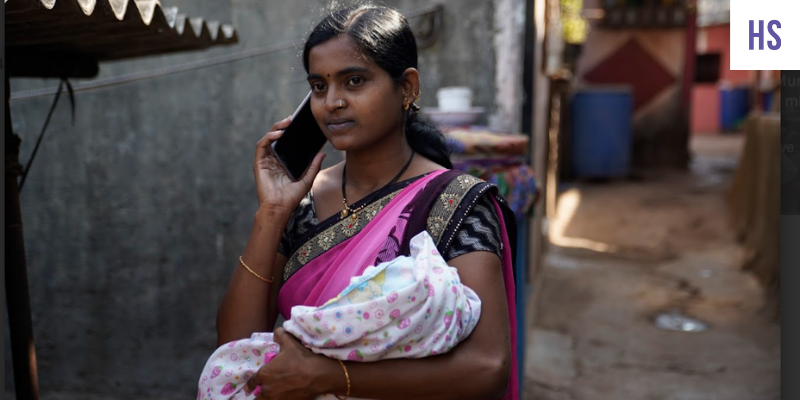In a country where maternal mortality remains alarmingly high, an innovative collaboration between ARMMAN, a nonprofit working on maternal and child health, and Google DeepMind’s AI for Social Good initiative is showing how artificial intelligence (AI) can become a powerful public health tool.
With millions of women and infants across India at risk, the partnership is leveraging AI to drive behavioural change and improve healthcare outcomes for underserved communities at scale.

Mother in rural Panipat listening to Kilkari calls
“We are grateful for the opportunity to show that AI can be taken out in the field and be used for the benefit of a larger population,” says Dr Milind Tambe, Director of AI for Social Good at Google DeepMind, who has co-led this initiative with Dr Aparna Hegde, founder of ARMMAN.
ARMMAN and its flagship programmes
Founded by urogynecologist and global health leader Dr Aparna Hegde, ARMMAN (Advancing Reduction in Mortality and Morbidity of Mothers, Children and Neonates) operates programmes that deliver preventive healthcare information to women during pregnancy and after childbirth.
The two core mobile health initiatives supported by AI are mMitra, a voice call service for pregnant women in urban poor communities, operational in Mumbai and Kilkari, a national government programme implemented by ARMMAN, delivering voice and multimedia messages to millions of women across India from pregnancy through the first year of a child’s life.
Despite the promise of these services, up to 40% of women were dropping out of the mMitra programme. The reasons ranged from shifting contact details to lack of motivation or attention. Similarly, in the Kilkari program, many mothers were missing the automated calls due to unsuitable time slots.
ARMMAN had already shown that consistent engagement—listening to the full series of health messages- leads to better maternal and child health. The challenge was to optimise limited resources and reach the women who needed support most, at the right time.
Enter AI: Predictive modeling for retention and reach

The call centre
“We had our first meeting with ARMMAN in Mumbai, and they told us about this problem,” recalls Dr Tambe. “That’s when we started focusing on building an AI model to reduce dropouts.”
For mMitra, the AI team at DeepMind developed a predictive model using anonymized data—such as age, income, education, language, and call listening behaviour—of around 200,000 women. Based on this data, the model could predict which mothers were at risk of dropping out and identify who would benefit most from an intervention call.
Since ARMMAN’s call centre could only reach around 1,000 women a week, this model helped prioritise support efficiently. The results were remarkable: a 30% improvement in retention, resulting in higher listenerhip and increased intake of essential supplements, such as iron and calcium.
“Based on features and past listening patterns, we could make a prediction as to who would shift to not listening next week,” explains Dr Tambe. “Then ARMMAN could intervene accordingly.”
Kilkari: Scaling without human intervention
The Kilkari programme posed a different challenge. There was no call centre, and millions of mothers were enrolled across India. Intervention calls weren’t feasible.
“In Kilkari, the only information available was the pickup behaviour of the mothers,” says Dr Tambe. “One mother might pick up calls at 2 PM while another might prefer 8 AM.”
Using this data, the AI model could predict the optimal time slots for different groups of mothers. A pilot study showed improvements of up to 12% in call pickup rates during specific time slots. “With a larger study over a longer time, we expect even better results,” he adds.
Hidden insights and frugal innovation
Interestingly, the AI model for mMitra also began surfacing unexpected but important patterns.
“We started identifying women who were likely facing pregnancy difficulties or miscarriages—just based on changes in their listening behaviour,” says Dr Tambe. This insight allowed ARMMAN to direct women to further counseling and care, even though that was not part of the model’s initial goal.
Another significant innovation was in frugal computing—developing models that require minimal computational resources so that they can scale without overwhelming the system. “The idea was to be able to deal with limited computing infrastructure. Many organisations face the challenge of limited resources in public health,” Dr Tambe explains.
A model for the future
Backed by strong pilot results and global recognition, this partnership stands as a powerful example of AI for social good in action.
“What started in 2019 as a small project to reduce dropouts has become a multi-year partnership,” says Dr Tambe. “We’ve been fortunate to work alongside ARMMAN and help improve health behaviors of mothers and babies across India.”
(The story has been updated to correct some typos.)

